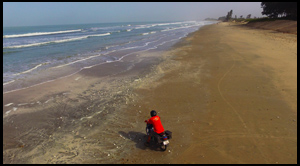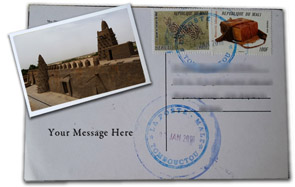Outside of Timbuktu, January 2012
I am back in Bamako now. Another 36 hour ride with Sama Transport in the books. Previous trips from Abidjan to Bamako (in 2012, at least) foreshadowed traumatic events in Mali. I arrived in Bamako a few hours before the coup last March. Several weeks later, I had a flight canceled because a red haze had swallowed Bamako. The flight was rescheduled and then canceled once again – counter-coup attempt. But there was nothing to foreshadow this time. The war started before I left.
In Bamako, life goes on as normal (more or less).
This is normal: I was in a SOTRAMA (Mali’s take on the minibus, a green shell ringed with wooden benches, infinite division of space, unlimited passengers) the other day and I watched a guy scoop up a baby from the arms of a mother who was burdened with several bags and a large plastic bowl overflowing with toothbrushes and tubes of toothpaste.
After she climbed into the SOTRAMA and arranged her merchandise, she did not ask for her baby back. Her baby remained in the arms of a stranger, who was now smiling and laughing with the woman’s daughter on his lap.
Two other women – strangers to each other – began a conversation that ended with reciprocal benedictions when they parted ways.
Everyone sucked their teeth in unison when a policeman stopped the SOTRAMA and asked to see IDs. But everyone quickly laughed when the prentike mocked the policeman and then dodged the outstretched hand intending to give him a playful slap on the head.
This scene of social harmony belies what’s happening elsewhere in the country. Cell networks have been cut by jihadists in Gao and Timbuktu, and those towns – and many others – may soon be facing severe food shortages. Timbuktu has reportedly been without electricity or water for 3 days (as of yesterday). Reprisals on the side of the Malian military have been reported in Sevare. And despite the precision of French bombing and the robust force that has been promised by other African countries, the jihadists are not planning on laying down their arms anytime soon. *Update* Many reports today indicating that Timbuktu and Gao could be in the hands of Malian/French/Chadian forces in the very near future.
While Mali settles into its temporary place on the airwaves, here are a few recommendations:
1. Be on the lookout for people who don’t know shit about Mali, but are using the current situation to reinforce their worldview. I actually think much of the reporting from Mali has been quite good. Editorials, on the other hand, have been mostly awful. If you want to call the intervention a war on Islam or a French neocolonial adventure, make sure that you are, you know, informed about what is really happening in Mali.
2. Speaking of being informed: Read Bruce Whitehouse’s blog here.
3. Pause. Watch Na Hawa Doumbia sing to these young boys under a tree in Bougouni back in the day:
Now listen to her daughter:
4. Read this from Hannah Armstrong. Trying to wrap your head around Islam in Mali? Hannah can help you figure it out with this strong piece.
5. Read this primer on the jihadists in Algeria and north Mali from Andrew Lebovich. Also, read the rest of his blog and follow him on twitter.
6. More great people to follow on twitter can be found in these lists compiled by Tommy Miles (1 and 2) and Stephanie Lamy (1 and 2). Oh yeah, follow them, too.
7. Francophone? See this list from Sonia Rolley. And yes, you should follow her, too.
8. Quality reporting from Peter Tinti can be found on his blog, where he also posts recommendations for further reading.
9. Pause for this Dri track.
Watch Iba One set a land speed record for bamanankan
10. Need some pictures? This photo essay from the Atlantic should do it. Some photos feature the work of Joe Penney who has also been offering informed reports on twitter.
11. Want some familiarity with north Mali? Check this multimedia site from Arnaud Contreras (twitter). Listen (and buy-the money supports northern artists) to the music on Sahel Sounds and read Chris Kirkley’s (twitter) beautiful narratives. Read some Andy Morgan (I’ve always felt Andy was a bit too supportive of MNLA during the heady days of the rebellion, but he is a brilliant writer and he has extensive experience in north Mali).
12. The music festivals of Segou and Essakane (more recently, Timbuktu) have been canceled this year. Let’s reflect on that:
Salif Keita performance at Segou in 2012 (tres chaud)
Amanar at Festival in the Desert 2010
Noura Mint Seymali at 2012 Festival in the Desert
Feel free to leave your own recommendations in the comments below.
Let’s all hope Mali gets back to being Maliba ASAP.





Lovely post. Some great links. In particular, thank you for introducing me to the work of Sahel Sounds.
Thanks, Rob. Happy to turn you onto Sahel Sounds. Incredible site/record label.
Brillant post. Lovely description of a Sotrama ride. Wholeheartedly endorse the thoughts and the reading recommendations. There’s an interesting looking panel discussion coming up at the Overseas Development Institute (in London but online too) featuring Bruce Whitehouse and others: http://www.odi.org.uk/events/3125-mali-humanitarian-conflict-counter-terrorism-sahel
Stephen,
Thanks a lot for the link. My internet connec is rarely up to the task of streaming video, but I will give it a shot 🙂
Thanks for the shout-out, Phil. Your anecdote about the Sotrama passengers helps me recall all those things I love about Mali that been lately obscured by the flood of worrying news. I’m grateful for the reminder.
I enjoyed reading Hannah Armstrong’s “Latitude” piece in the NY Times too, but her profile of the Haut Conseil Islamique passes pretty quickly over some crucial distinctions. The HCI is an umbrella group whose members indeed diverge over basic matters of dogma and practice; its leadership, however, has been dominated by conservative “reformists” like Mahmoud Dicko. I also don’t think the Cherif de Nioro is best described as an HCI leader, though he may have an affiliation with the organization.
Hey Bruce,
I am fairly ignorant of HCI and their inner workings, so thanks for this insight. Will you be coming back to Mali sometime soon?
No plans in the works, unfortunately. Our spring semester just started a couple of weeks ago, so I’m in the classroom for the next few months.
Hi Phil,
An be ñogon fe.
I’d love to meet you some time.
I’ll be back home in Lassa in February.
I remember speaking to you before about meeting up–I’m still down. Let me know when you arrive in Bamako.
Hi Bruce- Thanks for reading – that was of course a short post attempting to shed light on the HCI’s increasingly prominent role in Malian politics. There is no space in that format (my post was already way over the usual 600 words) for a deep look at internal politics of the HCI, which I’ll probably end up pursuing elsewhere. I did suggest that the conservative side is gaining ground with the anecdote about the Salafis winning the battle over Maouloud. There is no question that the Cherif of Nioro, who is seen as a religious leader, is affiliated with the HCI and appears at their events.
The Cherif is indeed a religious leader, has an HCI affiliation and appears at their events. The same applies to Cheick Ousmane Madani Haidara. Neither of these men could reasonably be described as an Islamist, however, and they are very much at odds with Dicko over a whole host of issues, Maouloud among them.
Phil –
Thank you so much for the wonderful post. The story of the Sotrama was spot on and brought back so many vivid memories of Bamako for me.
Please give the Karabenta’s my greetings and love.
And, have a meal at the Bistro for me. I remember the kabobs and haricots verts being particularly tasty.
Keep writing, reading, reflecting, watching, talking, and listening. Your voice is much needed!
Lots of love,
Jenny
Thanks, Jenny! Haven’t seen the Karabenta’s yet, but I hope to get over there during this next week. Will pass along your greetings!! Hope all is well in MI!
Thanks for including the amazing links… I haven’t been to Mali in six years, so it’s amazing to see how much has changed (it’s been a long hip-hop evolution from Les Escrocs to Iba One!) and how much has stayed the same (baby in Sotrama)! I ni ce kosebe, ala k’aw kisi jugu ma.
N ba. Amiiiiiiina!
Wow what an incredible resource of info! Stay safe!!!
Aww, thanks for that excellent description of the Sotrama. Makes me very homesick for my days as a PCV living in BKO. I always tried to participate in the random baby-sitting but occasionally set off a scared wail from the baby when confronted with my shiny toubab face. The benedictions, the communal laughter at the parantike, and the ease at which a stranger will pay the Sotrama fare for any musokoroba or cekoroba…these are little moments that I treasure in my memory of le vrai Mali.
Incidentally, I love following your tweets. Not on twitter myself, but between you, Peter Tinti, Joe Penney and Tommy Miles, I feel like I am keeping up with my former home. Best!
Bethany dit Koumba
Hi Bethany aka Koumba, thanks for the comment. Yes!! Paying the fare for older passengers is something I have seen before as well, powerful moments indeed. Where are you living now??
Thanks for the post Brother! The Doussou song has been playing on repeat in my car stereo and in my head for the past couple days. Amazing. The Hannah Armstrong piece was really great as well. Western journalists have not been successfully able to illustrate the complexity of the situation, so the links are much appreciated for those of us who have not traveled to Mali.
Irie,
Benjamin